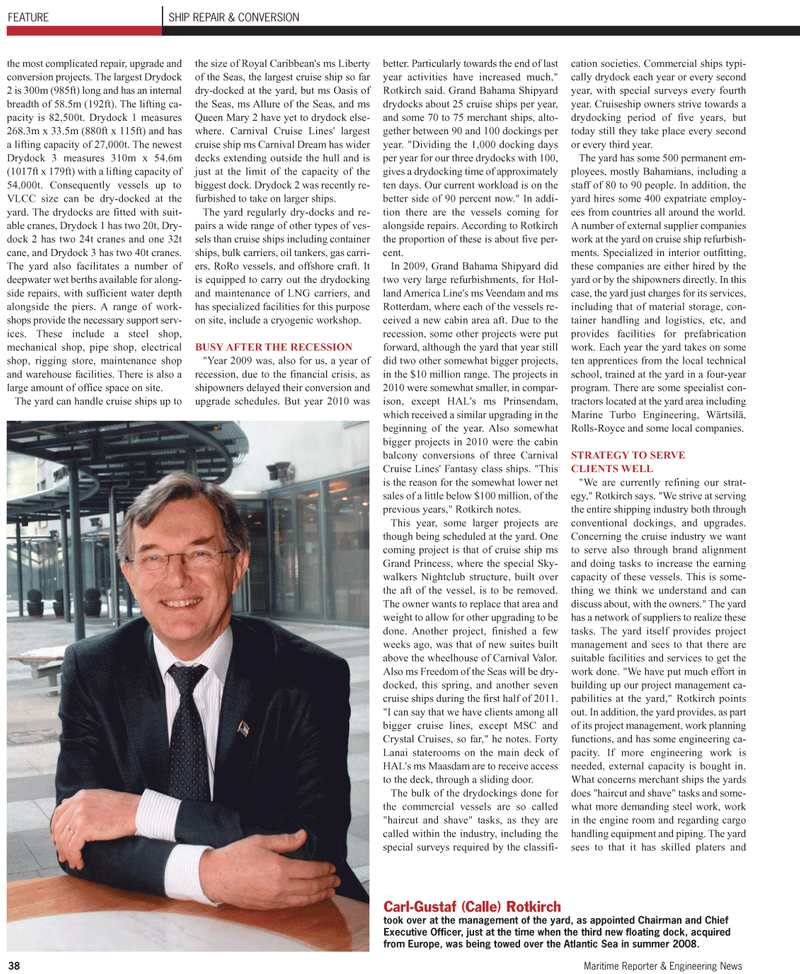
Page 38: of Maritime Reporter Magazine (March 2011)
Ship Repair & Conversion
Read this page in Pdf, Flash or Html5 edition of March 2011 Maritime Reporter Magazine
38 Maritime Reporter & Engineering News
FEATURE SHIP REPAIR & CONVERSION the most complicated repair, upgrade and conversion projects. The largest Drydock 2 is 300m (985ft) long and has an internal breadth of 58.5m (192ft). The lifting ca- pacity is 82,500t. Drydock 1 measures 268.3m x 33.5m (880ft x 115ft) and has a lifting capacity of 27,000t. The newest
Drydock 3 measures 310m x 54.6m (1017ft x 179ft) with a lifting capacity of 54,000t. Consequently vessels up to
VLCC size can be dry-docked at the yard. The drydocks are fitted with suit- able cranes, Drydock 1 has two 20t, Dry- dock 2 has two 24t cranes and one 32t cane, and Drydock 3 has two 40t cranes.
The yard also facilitates a number of deepwater wet berths available for along- side repairs, with sufficient water depth alongside the piers. A range of work- shops provide the necessary support serv- ices. These include a steel shop, mechanical shop, pipe shop, electrical shop, rigging store, maintenance shop and warehouse facilities. There is also a large amount of office space on site.
The yard can handle cruise ships up to the size of Royal Caribbean's ms Liberty of the Seas, the largest cruise ship so far dry-docked at the yard, but ms Oasis of the Seas, ms Allure of the Seas, and ms
Queen Mary 2 have yet to drydock else- where. Carnival Cruise Lines' largest cruise ship ms Carnival Dream has wider decks extending outside the hull and is just at the limit of the capacity of the biggest dock. Drydock 2 was recently re- furbished to take on larger ships.
The yard regularly dry-docks and re- pairs a wide range of other types of ves- sels than cruise ships including container ships, bulk carriers, oil tankers, gas carri- ers, RoRo vessels, and offshore craft. It is equipped to carry out the drydocking and maintenance of LNG carriers, and has specialized facilities for this purpose on site, include a cryogenic workshop.
BUSY AFTER THE RECESSION "Year 2009 was, also for us, a year of recession, due to the financial crisis, as shipowners delayed their conversion and upgrade schedules. But year 2010 was better. Particularly towards the end of last year activities have increased much,"
Rotkirch said. Grand Bahama Shipyard drydocks about 25 cruise ships per year, and some 70 to 75 merchant ships, alto- gether between 90 and 100 dockings per year. "Dividing the 1,000 docking days per year for our three drydocks with 100, gives a drydocking time of approximately ten days. Our current workload is on the better side of 90 percent now." In addi- tion there are the vessels coming for alongside repairs. According to Rotkirch the proportion of these is about five per- cent.
In 2009, Grand Bahama Shipyard did two very large refurbishments, for Hol- land America Line's ms Veendam and ms
Rotterdam, where each of the vessels re- ceived a new cabin area aft. Due to the recession, some other projects were put forward, although the yard that year still did two other somewhat bigger projects, in the $10 million range. The projects in 2010 were somewhat smaller, in compar- ison, except HAL's ms Prinsendam, which received a similar upgrading in the beginning of the year. Also somewhat bigger projects in 2010 were the cabin balcony conversions of three Carnival
Cruise Lines' Fantasy class ships. "This is the reason for the somewhat lower net sales of a little below $100 million, of the previous years," Rotkirch notes.
This year, some larger projects are though being scheduled at the yard. One coming project is that of cruise ship ms
Grand Princess, where the special Sky- walkers Nightclub structure, built over the aft of the vessel, is to be removed.
The owner wants to replace that area and weight to allow for other upgrading to be done. Another project, finished a few weeks ago, was that of new suites built above the wheelhouse of Carnival Valor.
Also ms Freedom of the Seas will be dry- docked, this spring, and another seven cruise ships during the first half of 2011. "I can say that we have clients among all bigger cruise lines, except MSC and
Crystal Cruises, so far," he notes. Forty
Lanai staterooms on the main deck of
HAL's ms Maasdam are to receive access to the deck, through a sliding door.
The bulk of the drydockings done for the commercial vessels are so called "haircut and shave" tasks, as they are called within the industry, including the special surveys required by the classifi- cation societies. Commercial ships typi- cally drydock each year or every second year, with special surveys every fourth year. Cruiseship owners strive towards a drydocking period of five years, but today still they take place every second or every third year.
The yard has some 500 permanent em- ployees, mostly Bahamians, including a staff of 80 to 90 people. In addition, the yard hires some 400 expatriate employ- ees from countries all around the world.
A number of external supplier companies work at the yard on cruise ship refurbish- ments. Specialized in interior outfitting, these companies are either hired by the yard or by the shipowners directly. In this case, the yard just charges for its services, including that of material storage, con- tainer handling and logistics, etc, and provides facilities for prefabrication work. Each year the yard takes on some ten apprentices from the local technical school, trained at the yard in a four-year program. There are some specialist con- tractors located at the yard area including
Marine Turbo Engineering, Wärtsilä,
Rolls-Royce and some local companies.
STRATEGY TO SERVE
CLIENTS WELL "We are currently refining our strat- egy," Rotkirch says. "We strive at serving the entire shipping industry both through conventional dockings, and upgrades.
Concerning the cruise industry we want to serve also through brand alignment and doing tasks to increase the earning capacity of these vessels. This is some- thing we think we understand and can discuss about, with the owners." The yard has a network of suppliers to realize these tasks. The yard itself provides project management and sees to that there are suitable facilities and services to get the work done. "We have put much effort in building up our project management ca- pabilities at the yard," Rotkirch points out. In addition, the yard provides, as part of its project management, work planning functions, and has some engineering ca- pacity. If more engineering work is needed, external capacity is bought in.
What concerns merchant ships the yards does "haircut and shave" tasks and some- what more demanding steel work, work in the engine room and regarding cargo handling equipment and piping. The yard sees to that it has skilled platers and
Carl-Gustaf (Calle) Rotkirch took over at the management of the yard, as appointed Chairman and Chief
Executive Officer, just at the time when the third new floating dock, acquired from Europe, was being towed over the Atlantic Sea in summer 2008.

 37
37

 39
39
